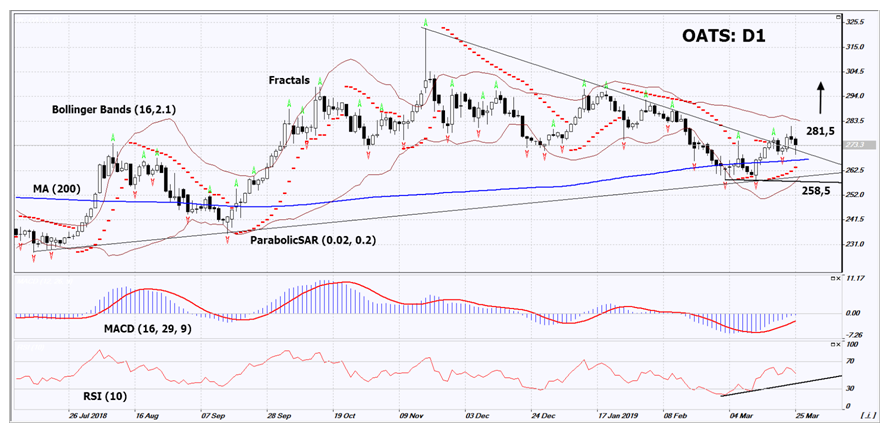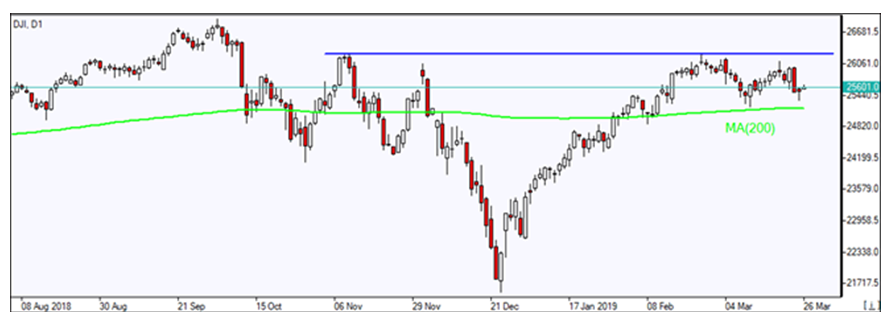There is severe flooding in the Midwestern United States, which could damage cereal crops. Will oat prices rise?
Because of the severe flooding on the Missouri River, crops in Montana, North Dakota and Nebraska may be damaged. However, it should be noted that the European Union, Russia and Canada are the world leaders in oat production. The United States is the largest importer of this type of grain, while China and Mexico are in the second and third places.

On the daily timeframe, OATS: D1 breached up the resistance line of the falling channel and the 200-day moving average line. A number of technical analysis indicators formed buy signals. The further price increase is possible in case of a reduction in world harvest.
- The Parabolic Indicator gives a bullish signal.
- The Bollinger bands® have narrowed, which indicates low volatility. The upper Bollinger band is titled upward.
- The RSI indicator is above 50. It has formed a positive divergence.
- The MACD indicator gives a bullish signal.
The bullish momentum may develop in case OATS exceed their last high at 281.5. This level may serve as an entry point. The initial stop loss may be placed below the two last fractal lows, the lower Bollinger band, the 200-day moving average line and the Parabolic signal at 258.5. After opening the pending order, we shall move the stop to the next fractal low following the Bollinger and Parabolic signals. Thus, we are changing the potential profit/loss to the breakeven point. More risk-averse traders may switch to the 4-hour chart after the trade and place there a stop loss moving it in the direction of the trade. If the price meets the stop level (258.5) without reaching the order (281.5), we recommend to close the position: the market sustains internal changes that were not taken into account.
Summary Of Technical Analysis
| Position | Buy |
| Buy stop | Above 281.5 |
| Stop loss | Below 258.5 |
Market Overview
- Global stocks mixed as slowdown concerns linger
- Dow edges higher led by Boeing data
- Brexit vote uncertainty weighs on European indices
-
Nikkei rebounds with Asian indices mixed
-
Brent up
US stock market slide continued on Monday. The S&P 500 slipped 0.1% to 2798.36. Dow Jones Industrial, however, managed to end 0.1% higher at 25516.83 thanks to Boeing Co (NYSE:BA) 2.3% rebound. The Nasdaq composite slid 0.1% to 7637.54. The dollar weakened: the live dollar index data show the ICE (NYSE:ICE) US Dollar index, a measure of the dollar’s strength against a basket of six rival currencies, slipped 0.1% to 96.482 but is higher currently. Futures on US stock indexes indicate higher openings today.

European stocks slide continued on Monday as investors confidence was undermined by yield curve Friday inversion - turning negative of spread between three-month and 10-year US bond yields. The GBP/USD turned lower while EUR/USD turned higher with both pairs lower currently. The Stoxx Europe 600 index lost 0.5% with all sectors down. The DAX 30 slid 0.2% to 11346.65 as Germany’s IFO Institute business climate index rose, beating a consensus forecast. France’s CAC 40 slipped 0.2% and UK’s FTSE 100 fell 0.2% to 7177.58.
Asian stock indices are mixed today as 10-year U.S. Treasury yield edged up to 2.442 percent. Nikkei rebounded 2.2% to 21428.39 as yen slide against the dollar accelerated. Markets in China are lower: the Shanghai Composite Index is down 1.5% and Hong Kong’s Hang Seng Index is 0.2% lower. Australia’s All Ordinaries Index recovered 0.1% despite Australian dollar continued climb against the greenback.
Brent futures prices are extending gains today still supported by OPEC supply cuts. Prices gained yesterday: May Brent crude rose 0.3% to $67.21 a barrel on Monday.
